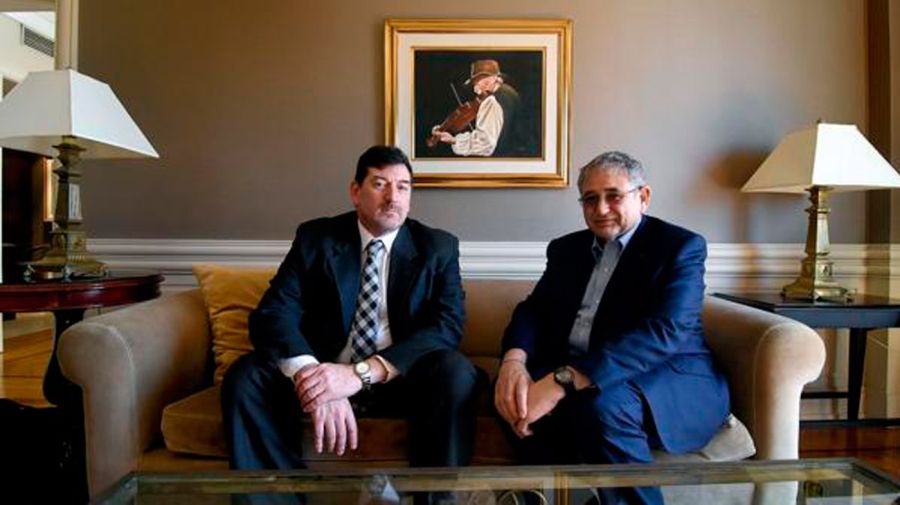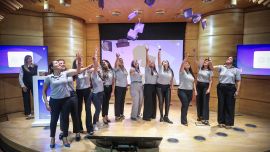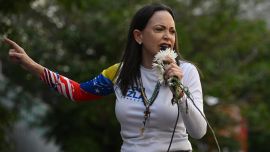-Where can I buy varenikes?
-At the shop around the corner.
-Ahh, are they Jewish?
-No, they are Italian.
This dialogue, at the end of the second decade of the 21st Century could have taken place at any major Metropolis in the world. But it is not from New York, Paris, or Buenos Aires. It occurred in a town in the northern Province of Santa Fe, Argentina, which, according to the 2010 census, contains 2,425 inhabitants.
The village is Moisés Ville.

from Simon Wiesenthal Center (left) with Dr Shimon Samuels, Director of International Relations of the Simon Wiesenthal Center.
In 1869, Argentina, a country roughly a quarter of the size of Europe, had no more than 2,000,000 inhabitants, almost the same population as today’s Vienna. Governments in the second half of the 19th Century invited the world to come and settle seeking new horizons in these lands. By the turn of the Century, the population had already doubled and by 1950 there were over 17 million people residing in the country.
This call was heard by many in distress who crossed the seas to try their fortune. Many stayed, others returned.
Following the execution of Tsar Alexander II in 1881, the living conditions of Jews in the Russian Empire worsened, confined in zones from which they could not leave, with groups of Cossacks commiting murder, rape, robberies and destruction known as Pogroms.
In the area called Podolia, in today’s Ukraine, a group of Jews obtained permission to leave, forced to sign a document allowing them to take with them what they could carry , handover what they could not and commit to never return.
Some 130 families headed to the port of Hamburg, where they embarked on the Wesser steamer, and after a difficult journey, arrived in Argentina in August 1889.
An endless train journey dropped them in a place called Palacios, in Santa Fe, more than 500 kilometers from Buenos Aires, and finally they settled naming the site Moisés Ville, the Village of Moses. The leader who brought the Jewish people out of slavery in Egypt more than 3,000 years ago, inspired this group of tattered immigrants with the image of a new Promised Land of Milk and Honey and a promising future.
Despite not knowing the local language, their different religion and customs and their ignorance of how to work the land, in only two generations they were integrated into society and building relations with the local population.
Synagogues, schools, cemeteries, and Jewish libraries and theatres were samples of a cultural splendor never before seen in those lands. Theatre plays in Yiddish were first released in Moisés Ville and later seen on Broadway.
This so-called “Jerusalem of Argentina” gave birth to great men and women who later sought to study and enter professions in large cities in different corners of this country and the world, never forgetting that magical and unique village in north central Argentina.
According to UNHCR, the United Nations Agency for Refugees, there are currently some 30 million migrants who have left their homelands.
The Simon Wiesenthal Center, an international human rights organization with more than 400,000 members worldwide, applies the lessons of the Holocaust to the daily struggle against racism, discrimination, xenophobia, anti-Semitism and terrorism. It is the only Jewish non-governmental organization accredited to the UNESCO World Heritage Committee.
In 2012, the Wiesenthal Center began its campaign to obtain World Heritage status for Moses Ville, to honour its first inhabitants and the land that received them ad to provide an example to the world of successful refugee absorption and integration through giving and receiving. The Jews who arrived in Moisés Ville were thankful for asylum and learned from their new homeland, without intent to alter it. Thus, they enriched their host country with their own history, and created with it a new cultural synthesis. Each year Moisés Ville celebrates a “Dia de la Convivencia” (Day of Harmony) with their Italian, Ukranian and native Gaucho neighbours, attended by families of former Moisés Villanos from Israel, United States, Europe and across Argentina.
In 2015, we applauded Argentina’s success in bringing Moisés Ville to the UNESCO Indicative List to eventually be designated as a World Heritage. The candidacy required rigorous work to achieve this objective, which was endorsed by President Macri in a meeting with the Wiesenthal Center’s leadership.
A professional team must now be employed to develop this project.
This requires moral and financial support.
The team that is leading this effort is Grup Moisés Ville Patrionio de la Humanidad, (which can be contacted by writing to the email address below). We look forward to your participation and contribution to this exciting Project.
One hundred and thirty years after the arrival of the Wesser steamship, this is a wonderful acknowledgement to the passengers and their successes.
Grup Moisés Ville Patrionio de la Humanidad can be contacted by writing to [email protected].

















Comments